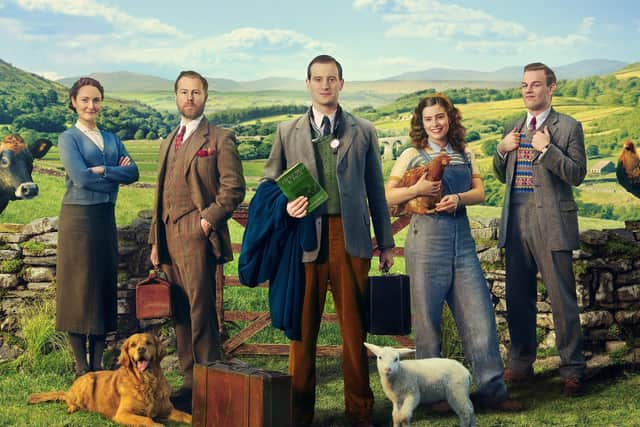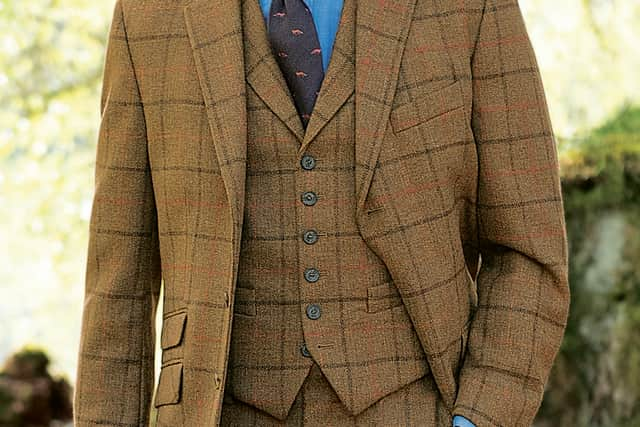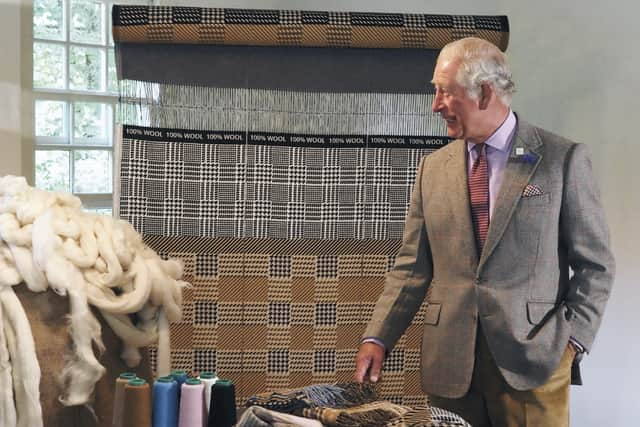All Creatures Great and Small sparks new tweed tailoring revival for 2021
If Siegfried Farnon were to walk down the high street today - any high street, from Grassington (the village that stands in for Darrowby in All Creatures Great and Small) to Parliament Street in Harrogate or Oxford Street in London - heads would turn because of his beautiful, characterful and eternally classic three-piece tweed suit. The on-screen wardrobes of Siegfried (Samuel West), James (Nicholas Ralph) and Tristan (Callum Woodhouse) are providing a welcome reminder of the sartorial elegance of tweed tailoring and accessories. The tweed pieces that the characters wear in the Channel 5 series are authentic, some period originals and some replicas of period designs, but they look as fresh, stylish and indeed as wearable today as they did back in the 1930s. Proof, if it were needed, of the longevity and investment potential of tweed.
Tweed is emerging from the tatters of the pandemic crisis as a wardrobe hero. Not least because British tweed – the quality stuff made here in Yorkshire and in Scotland – embodies the best of the movement we now call slow fashion.
Advertisement
Hide AdAdvertisement
Hide AdThis means responsible sourcing using natural, sustainable materials, with careful, time-honoured manufacturing processes throughout and then longevity as a piece of clothing both in terms of classic design and quality of product. Tweed really does represent a long-term investment.


Tweed was first created in the 18th century for Scottish farmers, and woven tightly to be wind and water resistant. Some believe the name “tweed” relates to the Tweed valley, but there is also the theory that, in 1826, a London shop clerk misread an order for “tweel” – the Scottish for twill – and the name stuck.
In the 1830s, wealthy estate owners chose tweed to make the staff uniforms, commissioning their own cloth to do so. As more machine weaving processes became involved, tweed turned more affordable. It became the fabric of choice for country sports with the earthy tones helping pursuers to blend into the surroundings. Prince Albert made tweed a must-have when he created a design for the Balmoral estate workers.
In the 1920s, Coco Chanel catapulted tweed into the world of high fashion after meeting the Duke of Westminster in 1923 in Monte Carlo. They became lovers for several years and she visited his estates in Scotland and England where she admired how the upper classes wore practical and stylish tweed for daily life. She commissioned a Scottish mill to produce her own tweed. In Gabrielle Chanel Fashion Manifesto, a beautiful coffee table book published last year, Alexandra Palmer writes: “She signed manufacturing agreements with English, Irish and Scottish factories, much to the ire of the French textile industry,” adding: “Reproductions of Chanel fashions stimulated sales of Chanel textiles, and was in part why Chanel could afford to be so cavalier about her fashions being copied.”
Advertisement
Hide AdAdvertisement
Hide AdBut British tweed producers did become protective. The 1993 Harris Tweed Act states that Harris Tweed must be made from pure virgin wool dyed and spun in the Outer Hebrides and made and finished by the islanders. Donegal tweed can be made only in Donegal.


Yorkshire is home to some of the world’s finest tweed manufacturers, with famous names including Marton Mills and Abraham Moon & Sons making for elite brands across the UK and the world.
Tweed patterning is distinctive and varied, with types including twill (with a subtle diagonal pattern that can look like a solid colour); checked; herringbone; overchecked; windowpane; striped; estate (usually a herringbone overlaid with a check); barleycorn tweed; houndstooth; dogtooth; and plaid (like tartan and often colourful).
Today tweed comes in a variety of weights. Heavy tweed is 500-600g, ideal for outdoor outerwear, giving protection when walking through bracken and heather. Medium tweed is 300g-400g, used for trousers, skirts, jackets and lighter coats. Light tweed is 250-320g and used for shirts and lightweight trousers or jackets, and for three-piece suits.


Advertisement
Hide AdAdvertisement
Hide AdIf you are looking to boost the tweed content of your wardrobe, Abraham Moon has a shop in York or head for Cordings in Harrogate (currently operating on an appointments-only basis, so email [email protected], and check out the website first). Montana in Northallerton is another sound choice, while Brook Taverner now has its own shops in Northallerton and Beverley. Boden has a lovely range made in fabrics woven by Abraham Moon.
There are many smaller designers too, well worth a look. Try Galijah and Frimble, both based in North Yorkshire, and for flat caps, check out Kempadoo Millar, which now has a shop in Knaresborough.
Ah, but what about caring for tweed? Most quality tweed is made of pure new wool, so it is best that you wash it a little as possible (and wool naturally has dirt-repelling qualities). Dry cleaning, when needed, is the best way to help tweed retain its shape, fit and look, but you can hand wash if you need to, following fine knitwear instructions, in cool, clean water using wool, cashmere shampoo or baby shampoo but not powder detergent.
House of Bruar recommends gently squeezing the suds th the garment, taking care not to wring, rub or stretch, then rinsing in fresh water. Do not lift the garment up as the wet fabric weighs more and will stretch. Gently squeeze excess water out and lay flat on a towel, reshaping as you do so. Then simply leave to dry naturally away from direct heat sources and out of sunlight.
With care, you will be able to pass on your tweeds to the next generation. Vintage tweed will always be on-trend.
Comment Guidelines
National World encourages reader discussion on our stories. User feedback, insights and back-and-forth exchanges add a rich layer of context to reporting. Please review our Community Guidelines before commenting.